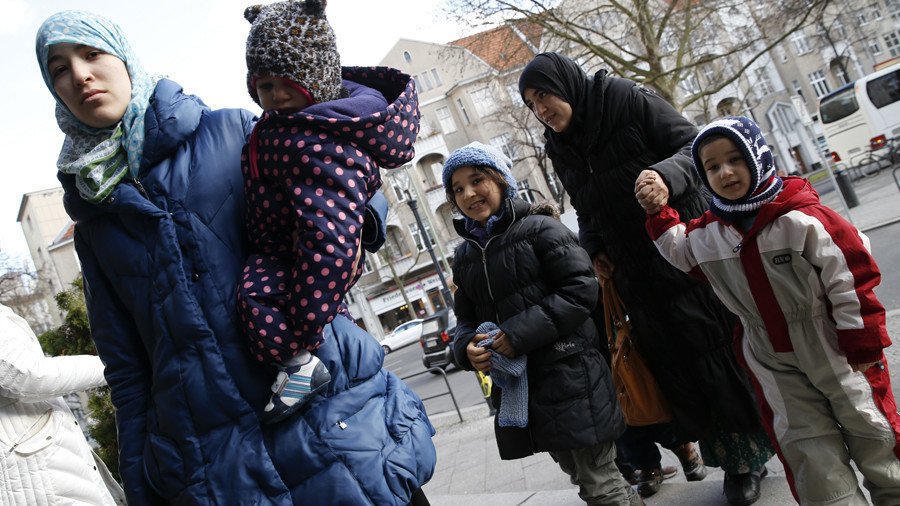Muslim population in Europe set to grow even with 'zero migration' – study

Europe’s Muslim population is set to multiply even if migration comes to a complete halt, a new study has found. Meanwhile, high migration could result in around 75 million Muslims living in the EU, Norway, and Switzerland by 2050.
Editor's note: This story’s previous headline incorrectly stated that Europe’s Muslim population would triple by 2050, even in the case of “zero migration.” This is not the case, as such a tripling effect could only occur under a “high migration” scenario.
A revealing survey by Pew Research Center, ‘Europe’s Growing Muslim Population’, looks at the future of the 25.8 million Muslims currently residing in European countries. Citing a comprehensive swath of data, it is an attempt to see how the size of Europe’s Muslim population may change in the coming decades, depending on levels of migration.
All three scenarios – zero, moderate and high – considered by researchers produced a thought-provoking outcome: the number of Muslims in Europe will rise at any rate of migration, as they are younger and “have higher fertility (one child more per woman, on average) than other Europeans, mirroring a global pattern.”
Under a first, “zero migration” scenario, the Muslim population of Europe still would be expected to rise from the current level of 4.9 percent to 7.4 percent (roughly 36 million) by the year 2050 even “if all migration into Europe were to immediately and permanently stop.”
A second, “medium” migration scenario assumes that the flows of refugees stop, but “regular” migrants continue to come for reasons other than fleeing wars and instability. Under these conditions, Muslims could comprise 11.2 percent (59 million) of Europe’s population in 2050.
In a third, “high” migration scenario, the heavy influx of predominantly Muslim migrants recorded between 2014 and 2016 continues indefinitely. In this case, Muslims could make up 14 percent (75 million) of Europe’s population by 2050 – nearly triple the current figure.
Should that happen, several major European countries are expected to shoulder most of the burden. In Sweden, nearly a third of the population (4.5 million, or 30 percent) would be Muslims, whereas in Austria and Germany Muslims would represent up to 19 percent of the population.
Also, if high migration continues until 2050, Britain’s Muslim share will grow to 17.2 percent, Finland’s to 15 percent and Norway’s to 17 percent.
These four maps show estimated Muslim populations in Europe in 2016, and projections for 2050 in zero migration, medium migration and high migration scenarios: https://t.co/52uWlFfSJhpic.twitter.com/mcDbWjuB5d
— Pew Research Religion (@PewReligion) November 29, 2017
“While Europe’s Muslim population is expected to grow in all three scenarios - and more than double in the medium and high migration scenarios – Europe’s non-Muslims, on the other hand, are projected to decline in total number in each scenario,” says the Pew report.
Interestingly, researchers noted that while Europe’s Muslim population is diverse, comprising Muslims born in Europe and in non-European countries, its self-identification still plays a role. “Levels of religious commitment and belief vary among Europe’s Muslim populations,” the report said.
Europe’s Muslim population is expected to grow in all three of the migration scenarios we modeled, while Europe’s non-Muslims are projected to decline in total number in each scenario https://t.co/iCiAB6ItXdpic.twitter.com/ZNK10XPvHL
— Pew Research Center (@pewresearch) November 30, 2017
While some of those Muslims “would not describe Muslim identity as salient in their daily lives,” for others, Islamic identity “profoundly shapes their daily lives.” In the meantime, “not all children born to Muslim women will ultimately identify as Muslims, but children are generally more likely to adopt their parents’ religious identity than any other.”
From mid-2010 to mid-2016 alone, the share of Muslims in Europe rose more than 1 percentage point, from 3.8% to 4.9% (from 19.5M to 25.8M). By 2050, the share of the continent’s population that is Muslim could more than double, rising to 11.2% or more. https://t.co/bfMHf8B798pic.twitter.com/JVy3j0tkde
— Pew Research Fact Tank (@FactTank) November 29, 2017
Researchers said it was difficult – if not impossible – to predict future migration levels. “Although none of these scenarios will play out exactly as projected, each provides a set of rough parameters from which to imagine other possible outcomes,” the study added.
There has been a heavy influx of migrants to Europe over the past two years, with Germany and Central European nations most affected, along with arrival points such as Italy and Greece.
READ MORE: No-go zones: Alt-right fantasy or new face of Europe?
The crisis gave rise to various far-right parties benefiting from popular fears of mass migration. In a bid to stem the flow of migrants, the EU undertook a major policy change, introducing tougher border controls and stricter eligibility criteria for new arrivals.
Previous polls suggested the majority of Europeans are wary of Muslim immigration. In August this year, Germany’s Bertelsmann Foundation found that every fifth European citizen does not want Muslims as neighbors. A February study by the UK-based think tank Chatham House revealed that an average of 55 percent of people in 10 European countries “agreed that all further migration from mainly Muslim countries should be stopped.”













